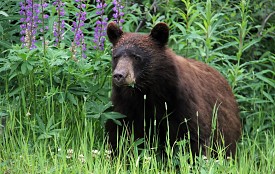Tips for Living Near Bears
 Bears are getting more and more comfortable these days when it comes to waltzing into your neighborhood and grabbing whatever they want. News of bear attacks is up, and densely populated regions across North America are taking steps to protect both bears and people. It’s possible for everyone to live in harmony, but it’s going to take a little work from the humans in the equation.
Bears are getting more and more comfortable these days when it comes to waltzing into your neighborhood and grabbing whatever they want. News of bear attacks is up, and densely populated regions across North America are taking steps to protect both bears and people. It’s possible for everyone to live in harmony, but it’s going to take a little work from the humans in the equation.
The Wild is Shrinking
Why the heck are bears so into human communities anyway? Don’t they have bear-like things to do in the wild? Well, “the wild” is actually shrinking; habitat is being destroyed at an alarming rate each year as a result of commercial, residential, and agricultural development. That puts pressure on bears to find new places to live, and to seek out new food sources, because their natural supplies of fish, berries, and plants are dwindling.
Bears Want your Food
Human communities offer something bears want, especially in August and September, when they’re preparing for a long hibernation: food. Most neighborhoods, as well as campsites, are like an all-you-can-eat buffet, open 24 hours a day for any bear enterprising enough to take a little stroll and see what’s available. Once bears learn that a neighborhood has one or more food sources, they’ll be back again and again!
Keep Food Supplies Locked up
If a community doesn’t have any food, bears might pass through, but they’re unlikely to cause any damage. They’re naturally pretty shy, and don’t really want to deal with humans if they can avoid it, although they may lash out if they’re diseased, feel threatened, or think they need to protect cubs. By keeping a community’s food supplies locked up, which involves working with everyone who lives there, it’s possible to encourage bears to move on to greener pastures—and to stay wild.
Don't Leave Food Outdoors
For starters, no loose food should be stored outside. All pet and livestock feed should be kept in bear-proof containers in secured areas like locked sheds, and if animals are fed outside, they should only be fed enough to supply their needs for a meal. Better yet, feed pets and livestock when they’re tucked indoors for the night, and make sure homes, stables, and similar structures are secured. If you feed birds, hang the feeders at least 20 feet off the ground and four to six feet away from tree trunks to make them hard to reach.
Bear Prevention in the Garden
If you’re a gardener (or you hire a pro to look after your garden), you’ll want to take some extra steps to avoid feeding the bears with your hard-grown produce! Harvest fruits and veggies as soon as they ripen, and keep your compost in a tightly secured area. Add lime to cut down on food smells. You may want to consider an electric fence to keep bears out of orchards, gardens, and other areas, and that goes double for beehives, because bears adore honey. Remember Winnie the Pooh? Yeah, it’s less cute when an actual black bear is homing in for a snack.
Bears and Compost
For even better bear control when it comes to compost, consider composting only grass and plant clippings outdoors, and using a vermicomposting system in the kitchen or a secure shed. Compost food waste there and add it to the soil when it’s mature, all while keeping it away from the sharp noses of ursine visitors. Either way, do not add animal products like bones to the compost, as these can be bear attractants even after the compost has broken down.
Get your Neighbors on Board
You’re going to need to get your neighbors on board with this plan so that when bears pop by for a round of shopping, they’ll find that all the stores are closed. If some of your neighbors can’t afford bear-proof containers and other safety measures, try creating a community fund or applying for assistance from government agencies. Make sure that everyone, including children, is educated about keeping food products out of range of bears.
Move Bears Along
And when bears do show up, make it clear that they need to move along. If you see a bear in the street or your yard and you can safely do so, make some noise. Clatter pan lids, use a wooden spoon on a pot, or use a bullhorn to startle the bear and encourage it to get out of the neighborhood. Do this from the safety of your home, but before you do so, check to make sure no one’s out in the street; a neighbor could be harmed if the bear startles.
Contact the Local Wildlife Services
If you notice a recurring visitor or a bear won’t leave, call your local division of wildlife services and ask for assistance. They can monitor the bear and remove it, if necessary, relocating it to a safer location where it can live out its natural life in conditions more appropriate for wildlife. Be aware that the longer bears have to get accustomed to living around humans, the harder it can be for them to return to the wild.
And we hope it goes without saying: don’t feed the bears!
Updated September 3, 2018.
Looking for a Pro? Call us (866) 441-6648

Pest control Average Costs
Exterminators Experiences

Look To Independent Contractors For Fast Service And Good Prices

Furnace Replacement So Our Heat Won’t Fail In The Winter Cold



